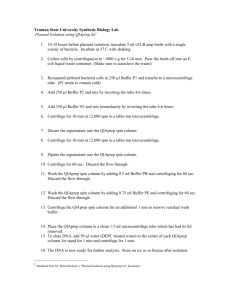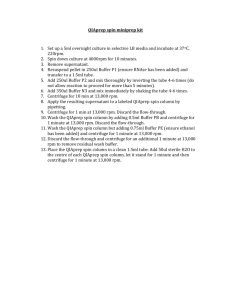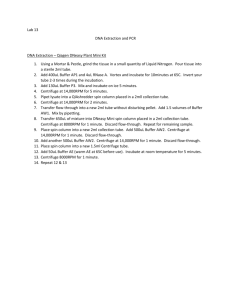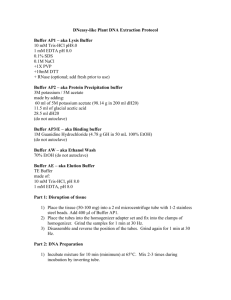7.13 Experimental Microbial Genetics MIT OpenCourseWare Fall 2008
advertisement
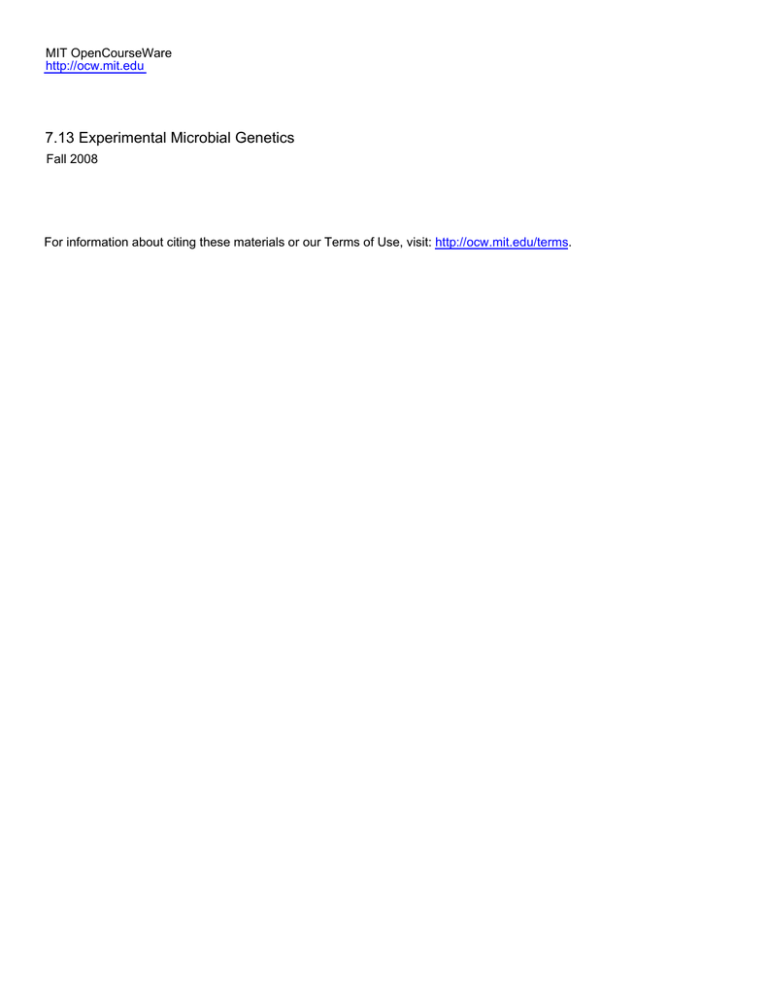
MIT OpenCourseWare http://ocw.mit.edu 7.13 Experimental Microbial Genetics Fall 2008 For information about citing these materials or our Terms of Use, visit: http://ocw.mit.edu/terms. 7.13 Fall 2008 Page |1 Plasmid DNA Purification Using the QIAprep Spin Miniprep Kit and a Microcentrifuge Before you start Add the provided RNase A solution to Buffer P1, mix, and store at 2–8°C (check for one in the fridge first). Add ethanol (96–100%) to Buffer PE (check label on cap to see if it has been added) before use (see bottle label for volume). Check Buffers P2 and N3 before use for salt precipitation. Redissolve any precipitate by warming to 37°C. Do not shake Buffer P2 vigorously. Close the bottle containing Buffer P2 immediately after use to avoid acidification of Buffer P2 from CO2 in the air. Buffers P2, N3, and PB contain irritants. Wear gloves when handling these buffers All protocol steps should be carried out at room temperature. All centrifugations from step 4 to end in the miniprep protocol are carried out at 13,000 rpm (~17,900 x g) Growth of bacterial cultures in tubes or flasks 1. Pick a single colony from a freshly streaked selective plate and inoculate a culture of 1–5 ml LB medium containing the appropriate selective antibiotic. Incubate for 12–16 h at 37°C with vigorous shaking (put tubes on carousel). Growth for more than 16 h is not recommended since cells begin to lyse and plasmid yields may be reduced. Use a tube or flask with a volume of at least 4 times the volume of the culture. Miniprep protocol This protocol is designed for purification of up to 20 µg of high-copy plasmid DNA from 1–5 ml overnight cultures of E. coli in LB (Luria-Bertani) medium. 1. Harvest the bacterial cells by centrifugation at > 8000 rpm (6800 x g) in a conventional, table-top microcentrifuge for 3 min at room temperature (15–25°C). Remove all traces of supernatant by inverting the open centrifuge tube until all medium has been drained. 2. Resuspend pelleted bacterial cells in 250 µl Buffer P1 and transfer to a microcentrifuge tube. Ensure that RNase A has been added to Buffer P1. No cell clumps should be visible after resuspension of the pellet. 2. Add 250 µl Buffer P2 and mix thoroughly by inverting the tube 4–6 times. Mix gently by inverting the tube. Do not vortex, as this will result in shearing of genomic DNA. If necessary, continue inverting the tube until the solution becomes viscous and slightly clear. Do not allow the lysis reaction to proceed for more than 5 min. 3. Add 350 µl Buffer N3 and mix immediately and thoroughly by inverting the tube 7.13 Fall 2008 Page |2 4–6 times. To avoid localized precipitation, mix the solution thoroughly, immediately after addition of Buffer N3. Large culture volumes (e.g. ≥5 ml) may require inverting up to 10 times. The solution should become cloudy. 4. Centrifuge for 10 min at 13,000 rpm (~17,900 x g) in a table-top microcentrifuge. A compact white pellet will form. 5. Apply the supernatants from step 4 to the QIAprep spin column by decanting or pipetting. 6. Centrifuge for 30–60 s. Discard the flow-through. 7. Wash the QIAprep spin column by adding 0.5 ml Buffer PB and centrifuging for 30–60s. Discard the flow-through. This step is necessary to remove trace nuclease activity when using endA+ strains such as the JM series, HB101 and its derivatives, or any wild-type strain, which have high levels of nuclease activity or high carbohydrate content. 8. Wash QIAprep spin column by adding 0.75 ml Buffer PE and centrifuging for 30–60 s. 9. Discard the flow-through, and centrifuge for an additional 1 min to remove residual wash buffer. Important: Residual wash buffer will not be completely removed unless the flowthrough is discarded before this additional centrifugation. Residual ethanol from Buffer PE may inhibit subsequent enzymatic reactions. 10. Place the QIAprep column in a clean 1.5 ml microcentrifuge tube. To elute DNA, add 50µl water (30µl if higher concentration is desired) to the center of each QIAprep spin column ensuring that it covers the whole membrane (don’t touch it with your tip), let stand for 1 min, and centrifuge for 1 min.

